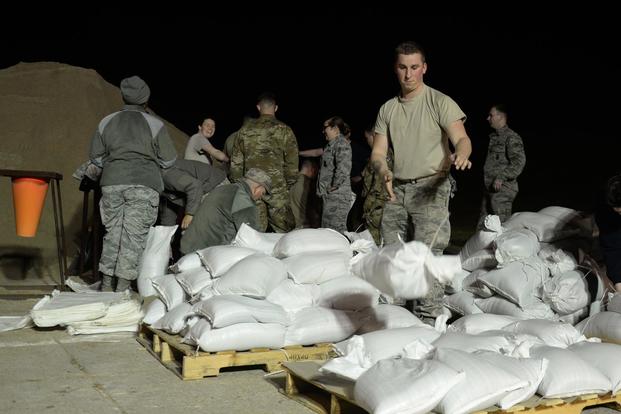Officials and airmen stationed at Offutt Air Force Base, Nebraska, will not be able to get into roughly 60 structures until water from massive floods over the weekend recedes across the base.
Only mission-essential personnel are working at the installation, and operators are hopeful they might be able to start reopening part of Offutt's flightline as early as tomorrow, according to base spokesman Ryan Hansen.
Floodwaters started encroaching on facilities Friday after water levels rose and broke levees from the Missouri River and Papillion Creek, known as the "Papio" Creek. The record floods are due to "a record-setting snowfall this winter, in addition to a huge drop in air pressure earlier in the week," Offutt said in a news release.
Offutt, home of the 55th Wing, evacuated and relocated nine aircraft as a result -- eight RC-135 Rivet Joint reconnaissance aircraft and one of Global Strike Command's E4-B Nightwatch aircraft, more commonly known as the "Doomsday" plane, Hansen said.
Half of the Rivet Joint aircraft were flown to Nebraska's Lincoln Air National Guard Base, and the other half to MacDill Air Force Base in Florida. Global Strike did not tell Military.com where the E-4B was located, citing operational security reasons. A spokeswoman for the command said the E-4B aircraft was not damaged.
Four RC-135s remain parked on the other side of the flightline, which is elevated. Roughly 3,000 feet of the runway remains submerged, Hansen said.
Some of the flooded buildings recorded water levels between six and eight feet, Hansen said.
The new $1.3 billion Strategic Command headquarters -- where the command is scheduled to move into this summer -- is "nowhere near" the impacted areas, Hansen said.
The small amount of housing on the base was unaffected, and the majority of off-base housing was also unharmed, because both communities were built on higher ground, Hansen said.
"I am foremost grateful there have been no injuries reported by our Airmen or their families, proud of the effort by our Airmen & the community there to take care of one another & confident in our ability to continue generating combat airpower as @Offutt_AFB recovers," Air Force Chief of Staff Gen. Goldfein tweeted on Monday.
Officials do not yet have an estimate for the damages sustained across the base.
Due west, the Nebraska National Guard's Camp Ashland remains completely submerged, according to aerial footage tweeted by Maj Gen. Daryl Bohac, the Adjutant General of the Nebraska National Guard. The training facility is roughly 25 miles from Offutt and sits adjacent to the Platte River.
In addition to emergency response, the Guard on Saturday was airborne in UH-60L Blackhawk helicopters dropping 1.5 tons in sandbags to create boundaries for wells that serve the city of Lincoln, Bohac tweeted.
The floods to multiple military installations come after a recent 22-page Defense Department climate study, which highlighted how bases around the country are faced with "significant vulnerabilities" due to climate change, and how the military itself must contend with new challenges due to "climate-related events."
The climate study said more than two-thirds of operational U.S. military installations are threatened by drought, recurrent coastal flooding, wildfires, extreme heat and extreme cold.
Last October, Tyndall Air Force Base, Florida, sustained severe damage during Hurricane Michael, which reached Category 4 status with 150 mph winds.
Much of Tyndall, including all of the base housing, suffered major damage when Michael came ashore on Oct. 10. All 11,000 personnel and family members were safely evacuated before the storm hit, and the vast majority of 5th-generation F-22 Raptors were flown to other bases. Over a dozen, however, were held back for maintenance reasons and got caught in the storm.
-- Oriana Pawlyk can be reached at oriana.pawlyk@military.com. Follow her on Twitter at @Oriana0214.














